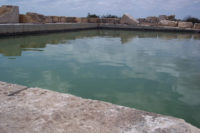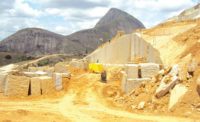“NSF International is an independent, not-for-profit, non-governmental public health and safety organization,” said Jamie Bush, Business Development Manager. “Its mission is to protect and improve human health and the environment. It carries it out by writing standards.”
The NSC is a not-for-profit organization formed in 2003 to unite a diverse group of natural stone producers. It worked in partnership with NSF and EcoForm to develop standard ANSI/NSC 373.
“The purpose is to recognize sustainability practices in the natural stone industry,” said Bush. “The standard establishes a set of environmental, ecological, social responsibility and human health metrics through a multi-stakeholder, science-based approach.”
“Certification of TexaStone as a sustainable producer of natural dimension stone products is a major milestone for NSC’s nearly five-year program to develop sustainability standards that dovetail with natural stone’s inherent qualities of beauty, durability and variety,” said Duke Pointer, executive director of the NSC. “We can now add certified sustainability to the world’s oldest building material. Brenda Edwards and the TexaStone team are to be congratulated for achieving this ‘first’ and we know the ability to use the NSC’s Gold and Silver certification seals in marketing will give her company a competitive advantage among those specifiers and users who thoroughly embrace the green movement and are looking for sustainability in the products they utilize in their projects.”
An overview
ANSI/NSC 373 standard applies to all processors of natural stone — from quarry operations through final stone fabrication, and is intended to allow for both domestic and international market participation from natural dimension stone producers, Bush explained. “There are 10 subject categories, which include required and optional criteria in each,” she said.
The categories are as follows:
• Section 5: Water (maximum six points)
• Section 6: Custody and transportation (two required credits only)
• Section 7: Site management (maximum four points)
• Section 8: Land reclamation and adaptive reuse (maximum seven points)
• Section 9: Corporate governance (maximum two points)
• Section 10: Energy (maximum seven points)
• Section 11: Management of excess process materials and solid waste (maximum five points)
• Section 12: Safer chemical and material management (maximum seven points)
• Section 13: Human health and safety (maximum two points)
• Section 14: Innovation (maximum four points)
Companies can receive four levels of Sustainable Product Achievement Certification:
• Bronze: All required criteria for each facility operator
• Silver: All required criteria and a minimum of eight points
• Gold: All required criteria and minimum of 15 points
• Platinum: All required criteria and minimum of 22 points
A total of 40 points can be achieved.
“NSC Chain of Custody Standard is the standard that applies for the certification of all Chain of Custody operations and may be combined with certification to ANSI/NSC 373 Sustainability Assessment for Natural Dimensional Stone, according to the scope of the organizations activities,” explained Bush. “For a product to be claimed as Genuine Stone certified, there must be an unbroken chain of certified organizations covering every change in the legal ownership of product from the certified quarry up to the point where the product is finished or sold to retail.”
The standard defines and addresses the basic elements of a Chain of Custody management system, which includes:
• Quality Management
• Material Receipt and Storage
• Volume Control
• Sales and Delivery
• General Labeling Requirements
• Outsourcing
The process
“The reason I did this was to help be a voice for the stone industry,” said Brenda Edwards, owner of TexaStone Quarries in Garden City, TX. “TexaStone is both a quarrier and fabricator of limestone. We applied for both certifications.”
Water
According to Edwards, the category on water was one of the more simple categories to complete. “Most of us use recycled water in our operations, mainly because we have very large expensive equipment, and if the water is not good, [the equipment] will not last,” she said. “So that’s usually an easy one for us to do. We already had meters on all of our water wells. It is a matter of record keeping, but water was pretty easy.”
Transportation
On the other hand, Edwards explained that the transportation category was a little more taxing. “I had a lot of sleepless nights on transportation,” she said. “But, I put my head in and figured out that the data ANSI/NSC 373 was asking for could be tracked easily through our accounting system. So, we went in and adjusted the accounting system so that everything is recorded — the DOT numbers, the truck, the weight of the stone and the distance of the travel. This is all for the Chain of Custody.
“Now, on our invoices, we give all this information,” Edwards went on to explain. “It gives us a report on a monthly basis. Also, at the end of the year we get an annual [report]. [Additionally], it gives out [the information] to our customers. If we send an invoice out with a certain weight on it, and then they weigh the stone when they get it and it is different, then there has been a problem along the way. So, it has been helpful.”
When it came to the transportation category, packaging material was something the company never considered. “This one really shocked me because I thought we were very efficient and cost effective,” said Edwards. “Once I had to get in to every single thing we use to pack and ship stone, I learned it is not very cost efficient at all. It was a real eye awakener to us.”
Site Management
In the quarry, Edwards explained that when a new pit is open, the company takes the overburden and the stone from the sludge and puts it aside. “We don’t want to move that stone from the site because when reclaiming, we want to put that back into the pit,” she said.
Edwards explained that ANSI/NSC 373 required TexaStone Quarries to open each of its quarry pits and determine if it is active or inactive. “We actually have 16 quarry pits, but we only keep six of them active,” she said. “We are certified for all six active ones.
“As for site management, we said we put all of our overburden and sludge over to the side for reclamation, but in the standard, it also considers it waste. This was something on our site visit, our auditor and I discussed. I explained our stance. He said, ‘You know, you are right, but the standard also says it’s waste.’ So, we take measurement of the pile and we can tell what the waste is due to the quarry size. That wasn’t quite as bad as we thought in the beginning.
Land Reclamation and Adaptive Reuse
“The State of Texas does not mandate that you reclaim a quarry, so this was a whole new process for us,” Edwards continued. “Reclamation says we need to go back to the natural habitat and vegetation. Fortunately, I live in the western part of Texas where it is desert and cactus grows naturally so it is pretty easy for us to reclaim a quarry pit. When you get to New York, Pennsylvania and Wisconsin, they have very strict reclamation. If they have to take a tree down, they have to plant two.”
For processing at the plant, TexaStone Quarries has signs for customer delivery. “We take what we call our scrap material and put it on pallets and sell it for the American Cancer Society. All proceeds goes to them,” said Edwards.
Corporate Government
According to Edwards, the Corporate Government category requires companies to abide by all labor laws and sexual harassment laws. “We have been doing this since day one, so all of our policies were in place,” said Edwards. “It was fairly easy.”
Energy
“Energy is one that took a little more effort on our part,” said Edwards. “Of course we have our electric bills. We have meters on all of our water wells and all our electric that supports the quarry. We kept all of our emissions vehicles and machines.
“NSF provided us with a spread sheet, and there is a formula that you use,” Edwards went on to explain. “We convert everything into kilowatt hours due to the fact of transportation. In transportation, you have to keep an inventory of the material that is trucked from our quarry to the fabrication. We keep an inventory of that. Then of course in fabrication, we keep an inventory of what is taken out and shipped to other places. With [the energy category], there is a spreadsheet. They want to know the kilowatt per ton. We transfer over to a spreadsheet on a yearly basis. This is also done in the quarry. Annual figures can be publicly viewed on our website, which is a requirement.”
To further meet demands of the “Energy” category, TexaStone Quarries installed lights that go out in the office. “We have taken our expensive lights out of the processing plant and replaced them with efficient lighting,” said Edwards.
Waste
According to Edwards, waste was the hardest category that TexaStone Quarries dealt with. “In limestone, we deal with a great amount of overcut,” she said. “You just have a lot of scrap material left. We put our heads together, and we are now doing several steps.
“In processing, we put scraps in the hopper,” Edwards went on to say. “Each is weighed and then goes to the scale. We keep tonnage of each hopper. Then, it is taken out and put in its proper place. We have a landfill over the hill trying to fill. Some goes there. Some goes to our American Cancer Society yard, and the remainder goes to a thinstone machine, and we create a thin veneer that is marketable. This is something we had not done prior to the standard, and it has helped so much. We have more product to sell. It really took a while to get there, but we did it.”
Safer Chemical and Material Management
Edwards explained that limestone doesn’t use a lot of chemicals. “We did it the hard way,” she said. “That’s okay. We learned a lot.
“We sent all our chemicals to NSF,” she went on to explain. “They said we sent more information than we needed to.”
TexaStone Quarries has safety meetings every single month religiously. “We have done that for 20 years, so that was not a problem,” said Edwards. “We believe in signage and keeping employees healthy, safe and [maintaining] a good environment.”
Benefits of ANSI/NSC 373 certification
“The entire standard benefitted our company because it showed us things we thought we were real efficient in and doing things the correct way, but when it came down to really getting to the nuts and bolts of the cost of everything, it made a big difference,” said Edwards. “When I see a crate sitting there, I know exactly how much it costs to ship out.”
When reflecting on the certification process, Edwards believes it was worth the effort. “At the end, I didn’t think it was that difficult,” she said. “It is very reachable and can benefit everyone.”











